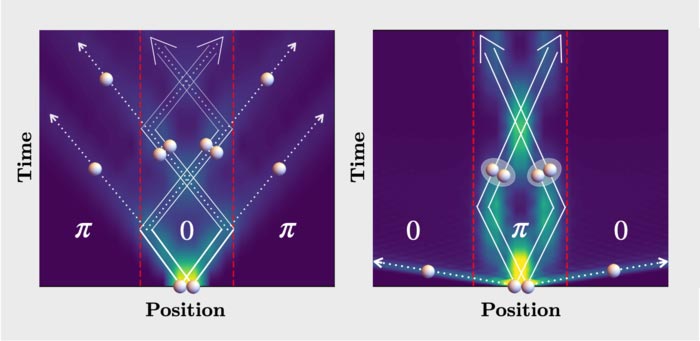Mutating quantum particles set in motion

Left: The particles start out as bosons and move together (solid lines) left and right before impinging on a 0-π; border, where they are partially reflected (solid lines) and partially split (dotted lines). For each splitting, one particle escapes the bosonic region. Right: Starting as pseudo-fermions, the particles move in a “superposition” of two ways: in one, they rapidly move apart as ordinary fermions and pass straight through the π-0 borders (dotted lines); in the other, they are bound together, move very slowly, and are forever trapped in the fermionic region (solid lines).
Credit: Lau and Dutta
Researchers from the Cavendish Laboratory have modelled a quantum walk of identical particles that can change their fundamental character by simply hopping across a domain wall in a one-dimensional lattice.
Their findings, published as a Letter in Physical Review Research, open up a window to engineer and control new kinds of collective motion in the quantum world.
All known fundamental particles fall in two groups: either a fermion (“matter particle”) or a boson (“force carrier”), depending on how their state is affected when two particles are exchanged. This “exchange statistics” strongly affects their behaviour, with fermions (electrons) giving rise to the periodic table of elements and bosons (photons) leading to electromagnetic radiation, energy and light.
In this new study, the theoretical physicists show that, by applying an effective magnetic field that varies in space and with the particle density, it is possible to coax the same particles to behave as bosons in one region and (pseudo)fermions in another. The boundaries separating these regions are invisible to every single particle and, yet, dramatically alters their collective motion, leading to striking phenomena such as particles getting trapped or fragmenting into many wave packets.
“Everything that we see around us is made up of either bosons or fermions. These two groups behave and move completely differently: bosons try to bunch together whereas fermions try to stay separate,” explained first author Liam L.H. Lau, who carried out this research during his undergraduate studies at the Cavendish Laboratory and is now a graduate student at Rutgers University.
“The question we asked was what if the particles could change their character as they moved around on a one-dimensional lattice, our notion of space.”
This research is partly motivated by the remarkable prospects of being able to control the nature of particles in the laboratory. In particular, certain two-dimensional materials have been found to host particle-like excitations that are in between bosons and fermions – called “anyons” – which could be used to build robust quantum computers. However, in all setups so far, the nature of the particles is fixed and cannot be changed in space or time.
By analysing mathematical models, the present study shows how one can juxtapose bosonic, fermionic, and even “anyonic” spatial domains in the same physical system, and explores how two particles can move in surprising ways through these different regions.
“The boundaries separating these regions are very special, because they are transparent to single particles and, yet, control the final distribution by how they reflect or transmit two particles arriving together!” said Lau. The researchers illustrate this “many-body” effect by studying different arrangements of the spatial domains, which give rise to strikingly different collective motion of the two particles.
“These variable two-particle interferences are fascinating in their own rights, but the new questions they open up for many particles are even more exciting,” said Dr Shovan Dutta, the study’s co-author who conceived and supervised the research in the Cavendish and has recently moved to the Max Planck Institute for the Physics of Complex Systems.
“Our work builds on recent progress in engineering artificial magnetic fields for neutral atoms, and the predictions can be tested experimentally in existing optical-lattice setups,” added Dutta. “This will open access to a rich class of controllable many-particle dynamics and, potentially, technological applications, including in quantum sensing.”
Journal: Physical Review Research
DOI: 10.1103/PhysRevResearch.4.L012007
Article Title: Quantum walk of two anyons across a statistical boundary
Article Publication Date: 31-Jan-2022
Media Contact
Vanessa Bismuth
University of Cambridge
vanessa.bismuth@phy.cam.ac.uk
Office: 07-707-288-203
All latest news from the category: Physics and Astronomy
This area deals with the fundamental laws and building blocks of nature and how they interact, the properties and the behavior of matter, and research into space and time and their structures.
innovations-report provides in-depth reports and articles on subjects such as astrophysics, laser technologies, nuclear, quantum, particle and solid-state physics, nanotechnologies, planetary research and findings (Mars, Venus) and developments related to the Hubble Telescope.
Newest articles

Pinpointing hydrogen isotopes in titanium hydride nanofilms
Although it is the smallest and lightest atom, hydrogen can have a big impact by infiltrating other materials and affecting their properties, such as superconductivity and metal-insulator-transitions. Now, researchers from…

A new way of entangling light and sound
For a wide variety of emerging quantum technologies, such as secure quantum communications and quantum computing, quantum entanglement is a prerequisite. Scientists at the Max-Planck-Institute for the Science of Light…

Telescope for NASA’s Roman Mission complete, delivered to Goddard
NASA’s Nancy Grace Roman Space Telescope is one giant step closer to unlocking the mysteries of the universe. The mission has now received its final major delivery: the Optical Telescope…



